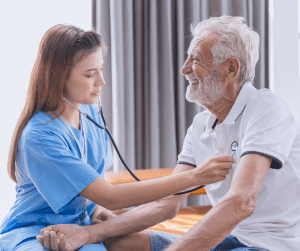February is National Heart Health Month: How Pemi-Baker Hospice & Home Health Supports Patients and Families.
 February is National Heart Health Month, a time to focus on cardiovascular wellness and the resources available to support patients recovering from heart conditions. Pemi-Baker Hospice & Home Health is proud to provide compassionate, high-quality care to individuals transitioning home after heart surgery and families living with terminal heart disease.
February is National Heart Health Month, a time to focus on cardiovascular wellness and the resources available to support patients recovering from heart conditions. Pemi-Baker Hospice & Home Health is proud to provide compassionate, high-quality care to individuals transitioning home after heart surgery and families living with terminal heart disease.
For those recovering from heart surgery, the journey back to health can be daunting. Pemi-Baker’s dedicated home health team ensures that patients receive expert care in the comfort of their own homes. Our skilled nurses, therapists, and caregivers work together to create personalized care plans tailored to the unique needs of each patient.
“Our home health services focus on a holistic approach to recovery,” says Aubrey Engle, Executive Director. “From monitoring vital signs and administering medications to guiding patients through cardiac rehabilitation exercises, our team is here to help patients regain strength and confidence after surgery.”
Transitioning home after heart surgery often requires significant lifestyle adjustments, including managing medications, maintaining a heart-healthy diet, and adhering to physical activity recommendations. Pemi-Baker’s team provides essential education and support to both patients and their families, empowering them to take control of their health and reduce the risk of complications or hospital readmissions.

In addition to post-surgery care, Pemi-Baker Hospice & Home Health offers specialized hospice services for families facing terminal heart disease. Many people delay seeking hospice care, but early enrollment can provide invaluable benefits to both patients and their loved ones.
“Our hospice services are about more than end-of-life care,” says Engle. “We focus on enhancing quality of life, providing emotional and spiritual support, and ensuring patients can spend their remaining time with dignity and comfort.”
The Pemi-Baker team includes skilled clinicians, social workers, chaplains, and trained volunteers who provide a network of support. This comprehensive care helps families navigate the physical, emotional, and logistical challenges of terminal heart disease. From managing symptoms like shortness of breath and fatigue to addressing emotional concerns, Pemi-Baker’s hospice team is committed to helping patients and families find peace during a difficult time.
National Heart Health Month is an ideal time to prioritize your heart health and learn about the resources available to support recovery and long-term care. Whether you or a loved one are recovering from heart surgery or facing a terminal diagnosis, Pemi-Baker Hospice & Home Health is here to help.
Don’t wait to ask about how our compassionate staff can help your loved ones. To qualify for home health care, a person must have a physician’s order and demonstrate a need for skilled care that can be safely provided at home. Our focus is on providing comfort to patients and support to families, with our team available 24/7 to address any concerns. The call is free, and our professionals are ready to assist you! Call us today at 603-536-2232 to learn more.





 Contact Anna Swanson by phone or email today and become better prepared to save a life!
Contact Anna Swanson by phone or email today and become better prepared to save a life!















